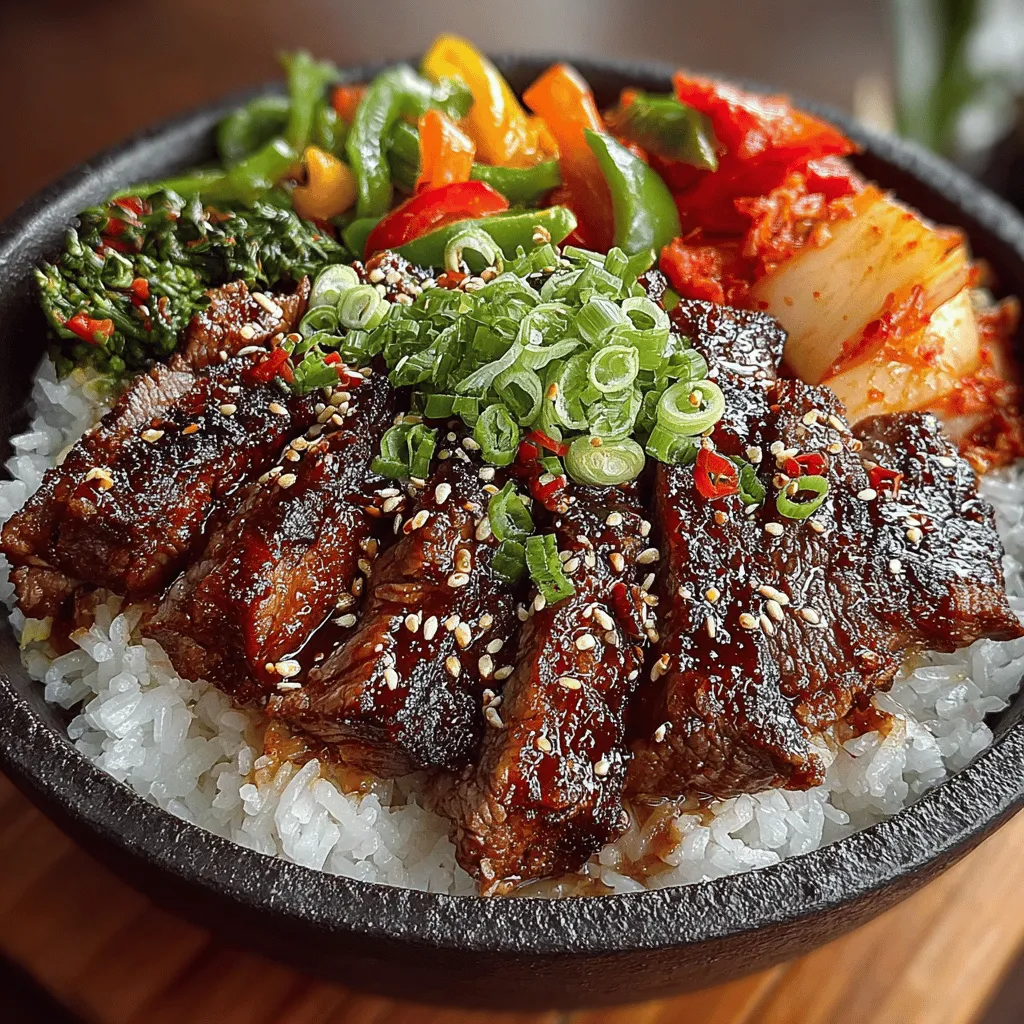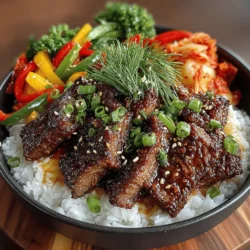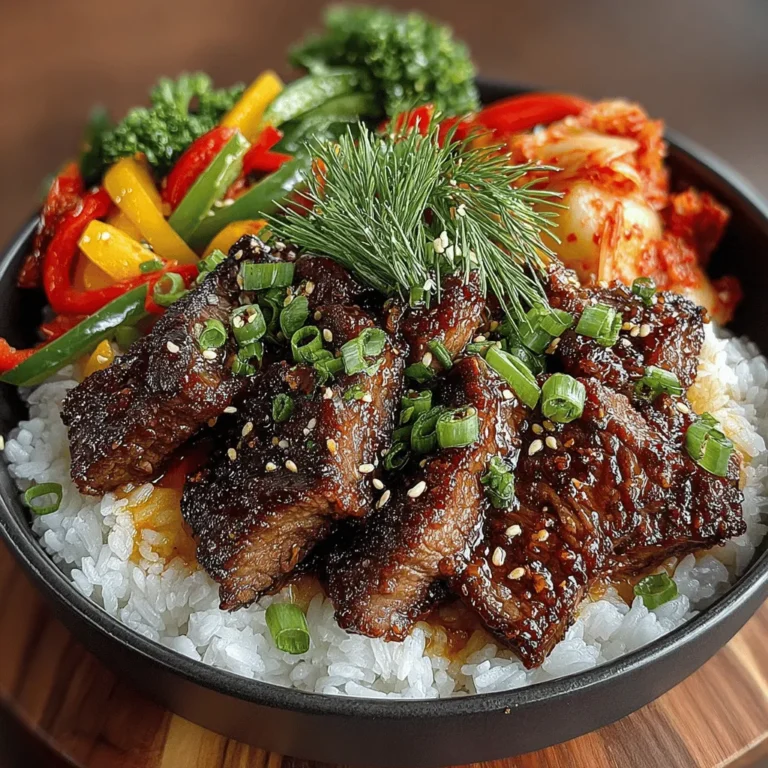Sweet & Spicy Korean Beef Bowls: A Culinary Delight
Korean cuisine is a vibrant tapestry of flavors and textures, renowned for its ability to balance sweet, spicy, and savory elements in a single dish. The rich culinary heritage of Korea is reflected in its use of fresh ingredients, bold spices, and fermentation, creating a dining experience that is as much about the flavors as it is about the harmony of the meal. Among the many beloved dishes that exemplify these traits, Sweet & Spicy Korean Beef Bowls have emerged as a favorite for home cooks seeking a satisfying and quick weeknight meal.
This dish encapsulates the essence of Korean cooking with its enticing combination of tender beef, a punch of heat from gochujang, and the comforting sweetness of brown sugar. The result is a flavor-packed bowl that can be prepared in under an hour, making it a perfect choice for those busy weeknights when you crave something delicious but don’t have hours to spend in the kitchen.
A Flavorful Balance
At the heart of Sweet & Spicy Korean Beef Bowls lies a remarkable balance of flavors. The heat from gochujang, a staple in Korean kitchens, combines beautifully with the sweetness from brown sugar, creating a rich sauce that clings to the beef and vegetables. This interplay of sweet and spicy not only satisfies the palate but also provides a deeper culinary experience that reflects the complexity of Korean cuisine.
As we delve into the preparation of this dish, it’s essential to understand the key ingredients that make it shine. Each component plays a critical role in building the flavors that define this beloved bowl.
Understanding the Ingredients
Overview of Key Ingredients
1. Flank Steak: The star of our Sweet & Spicy Korean Beef Bowls is flank steak, a cut known for its rich flavor and tenderness when cooked properly. In Korean cooking, flank steak is often used for its ability to absorb marinades and retain moisture during cooking, resulting in juicy bites packed with flavor. Thinly slicing the flank steak against the grain ensures it remains tender and easy to chew, making it perfect for this dish.
2. Gochujang: This fermented chili paste is a cornerstone of Korean cooking. Made from red chili powder, glutinous rice, fermented soybeans, and salt, gochujang is known for its complex flavor profile, adding heat and depth to dishes. In the context of our Sweet & Spicy Korean Beef Bowls, gochujang provides the spice element that balances the sweetness from the brown sugar, creating a well-rounded sauce that enhances the overall dish.
Marinade Components
To create the perfect Sweet & Spicy Korean Beef Bowls, we will prepare a marinade that brings together a variety of flavors:
– Soy Sauce: This umami-rich condiment is essential in many Asian cuisines. In our marinade, soy sauce contributes saltiness and depth, enhancing the natural flavors of the beef. It also helps tenderize the meat, making it more enjoyable to eat.
– Brown Sugar: The sweetness of brown sugar complements the heat of gochujang, creating a beautiful balance. As the beef cooks, the sugar caramelizes, adding a rich, complex flavor to the dish.
– Sesame Oil: A drizzle of sesame oil adds a nutty aroma and flavor that is distinctly Korean. This oil not only enhances the taste but also contributes to a glossy finish on the beef and vegetables.
– Garlic: Fresh garlic adds a pungent, aromatic quality to the marinade, enhancing the overall flavor profile of the dish. Its sharpness contrasts beautifully with the sweetness of the brown sugar.
– Ginger: Ground ginger or fresh ginger adds a warm, spicy note to the marinade, complementing the heat from the gochujang and adding depth to the dish.
– Rice Vinegar: A splash of rice vinegar introduces acidity, balancing the sweetness and heat while adding a fresh brightness to the overall flavor.
– Cornstarch: Used as a thickening agent, cornstarch helps create a luscious sauce that clings to the beef and vegetables, ensuring every bite is flavorful.
Each of these ingredients contributes not just to the flavor but also to the texture and aroma of the dish, making it a delightful culinary experience.
Marinating the Beef
The marinating process is crucial for maximizing flavor and tenderness. Here’s a step-by-step guide to marinating the flank steak for your Sweet & Spicy Korean Beef Bowls:
1. Prepare the Marinade: In a medium bowl, combine soy sauce, brown sugar, gochujang, sesame oil, minced garlic, grated ginger, rice vinegar, and cornstarch. Whisk until well combined, ensuring that the brown sugar dissolves completely.
2. Slice the Flank Steak: Using a sharp knife, slice the flank steak against the grain into thin strips, about 1/4 inch thick. This technique breaks down the muscle fibers, making the meat tender.
3. Marinate the Beef: Place the sliced flank steak in a resealable plastic bag or a shallow dish. Pour the marinade over the beef, ensuring that all pieces are well coated. Seal the bag or cover the dish with plastic wrap.
4. Marination Time: For optimal flavor, allow the beef to marinate for at least 30 minutes at room temperature, or up to 2 hours in the refrigerator. If you have time, marinating overnight will yield even deeper flavors.
Marinating not only infuses the beef with flavor but also helps to tenderize it, ensuring that the final dish is juicy and full of taste.
Cooking the Vegetables
While the beef is marinating, it’s important to prepare the vegetables that will accompany this dish. The right vegetable selection not only adds color and texture but also balances the meal nutritionally.
1. Choosing Your Vegetables: Bright, crisp vegetables like bell peppers, broccoli, carrots, and snap peas work wonderfully in this dish. They add a refreshing crunch and vibrant colors that enhance the overall presentation.
2. Stir-Frying Techniques: To retain the nutrients and crunch of the vegetables, use high heat and a quick stir-frying technique. Heat a tablespoon of oil in a large skillet or wok until shimmering. Add the vegetables in batches, allowing them to cook for just a few minutes until they are tender-crisp. Stir-frying at high heat seals in the flavor and keeps the vegetables looking bright and appealing.
By understanding the ingredients and preparing each component carefully, you set the stage for a flavorful and satisfying meal. The Sweet & Spicy Korean Beef Bowls promise a delightful experience that embodies the essence of Korean cuisine, blending sweetness and spice in every bite.

Suggestions for Additional Vegetables That Can Be Used
While the classic Sweet & Spicy Korean Beef Bowls feature a delightful combination of beef and traditional toppings, adding a variety of vegetables can elevate both the taste and nutritional value of the dish. Here are some excellent vegetable options to consider:
– Bell Peppers: Sliced bell peppers add a crisp texture and vibrant colors. They also bring a mild sweetness that complements the spicy beef.
– Carrots: Thinly sliced or julienned carrots provide a nice crunch and a hint of sweetness, enhancing the overall flavor profile.
– Zucchini: Sautéed or grilled zucchini offers a lightness to the dish and absorbs the flavors of the sauce beautifully.
– Broccoli: Steamed or roasted broccoli not only adds a pop of green but also boosts the fiber content, making your meal more filling.
– Snap Peas: These can be added towards the end of cooking for a fresh and crunchy texture that contrasts well with the tender beef.
– Mushrooms: Shiitake or button mushrooms can add umami and a meaty texture, making them an excellent addition for mushroom lovers.
Feel free to mix and match these vegetables based on your preferences or what you have on hand, creating a unique twist on this traditional dish.
Cooking the Beef
Best Practices for Searing Beef for Maximum Flavor
Searing beef is a crucial step in developing rich flavors in your Sweet & Spicy Korean Beef Bowls. Here are some best practices to ensure you achieve that perfect sear:
1. Use High Heat: Preheat your skillet or wok on medium-high heat. A hot surface is essential for creating a good sear and browning the meat effectively.
2. Pat the Beef Dry: Before cooking, ensure your beef is patted dry with paper towels. This step removes excess moisture, allowing for better caramelization.
3. Don’t Overcrowd the Pan: Cook the beef in batches if necessary. Overcrowding the pan causes the temperature to drop, which can lead to steaming instead of searing.
Tips on Achieving the Perfect Caramelization
Caramelization is key to unlocking the depth of flavor in your beef. Here’s how to achieve that golden-brown crust:
1. Avoid Stirring Too Much: Once you place the beef in the pan, let it sear without stirring for a few minutes. This allows a crust to form.
2. Use a Cast Iron Skillet: If possible, opt for a cast iron skillet, as it retains heat well and provides an even cooking surface.
3. Add a Touch of Sugar: Incorporating a small amount of sugar into your marinade or directly into the pan can help achieve that caramelized finish.
How to Know When the Beef Is Cooked Through Without Losing Tenderness
Cooking beef to the right doneness without sacrificing tenderness is essential. Here’s how to gauge it:
– Use a Meat Thermometer: For medium-rare, aim for an internal temperature of 130°F to 135°F. For medium, go for 140°F to 145°F.
– Check for Color: The beef should be browned on the outside while still slightly pink on the inside. This indicates a juicy, tender piece of meat.
– Let It Rest: After cooking, allow the beef to rest for a few minutes before slicing. This helps redistribute the juices, keeping the meat tender and flavorful.
Assembling the Bowls
Guidelines for Portioning Jasmine Rice or Cauliflower Rice
The base of your Sweet & Spicy Korean Beef Bowls can be made with either jasmine rice or cauliflower rice, depending on your dietary preferences. Here’s how to portion them effectively:
– Jasmine Rice: A standard serving size is about 1 cup cooked per person. Fluff the rice with a fork before portioning to ensure it’s light and airy.
– Cauliflower Rice: If choosing cauliflower rice for a lower-carb option, a serving size is typically around 1 to 1.5 cups. Sauté it lightly with a bit of oil and seasoning for added flavor.
Creative Ways to Layer Ingredients for Presentation
Layering your ingredients thoughtfully not only enhances the visual appeal but also ensures a balanced bite with every forkful. Here are some ideas for layering:
1. Start with the Base: Spoon the rice into the bottom of the bowl to create a solid foundation.
2. Add the Beef: Place the seared beef on top of the rice, allowing the juices to soak into the grains.
3. Layer the Vegetables: Arrange your chosen vegetables around the beef, showcasing a colorful array.
4. Finish with Toppings: Sprinkle sesame seeds, chopped green onions, and any other garnishes on top for a finishing touch.
The Significance of Garnish in Enhancing Visual Appeal and Flavor
Garnish plays a vital role in both presentation and flavor. Here’s how to make the most of it:
– Fresh Herbs: Chopped cilantro or green onions not only add a pop of color but also a burst of freshness.
– Sesame Seeds: Toasted sesame seeds add a nutty flavor and a bit of crunch, enhancing the overall texture of the dish.
– Pickled Vegetables: A small side of pickled radishes or kimchi can introduce a tangy flavor that contrasts beautifully with the savory beef.
Serving Suggestions
Discussing Optional Sides, Such as Kimchi, to Complement the Meal
To elevate your Sweet & Spicy Korean Beef Bowls, consider serving them with a few complementary sides:
– Kimchi: This fermented vegetable dish is a staple in Korean cuisine. Its spicy and sour profile pairs perfectly with the sweet and spicy flavors of the beef.
– Korean Potato Salad: A creamy potato salad can provide a cooling balance to the heat of the beef.
– Sautéed Greens: Lightly sautéed greens like bok choy or spinach add a nutritious element to your meal.
Ideas for Pairing the Bowls with Beverages or Additional Dishes
When it comes to pairing beverages, consider these options:
– Soju: A traditional Korean spirit, soju is a popular choice that complements the flavors of the dish.
– Green Tea: A warm cup of green tea provides a refreshing palate cleanser between bites.
– Korean Beer: Light lagers or wheat beers can enhance the overall dining experience.
Nutritional Breakdown
Overview of the Nutritional Benefits of the Main Ingredients
The Sweet & Spicy Korean Beef Bowls are not only delicious but also packed with nutritional benefits:
– Beef: A great source of protein, iron, and B vitamins that supports muscle health and energy levels.
– Vegetables: Adding a variety of vegetables boosts fiber, vitamins, and antioxidants, contributing to overall health.
– Rice: Jasmine rice serves as a good source of carbohydrates for energy, while cauliflower rice provides fiber and low-calorie benefits.
Caloric Content and Health-Conscious Options (Like Cauliflower Rice)
– Caloric Content: A typical serving of beef with jasmine rice (about 1 cup cooked) can range from 600 to 800 calories, depending on the amount of sauce and toppings used.
– Health-Conscious Options: By swapping jasmine rice for cauliflower rice, you can reduce the calorie count significantly, making it a great alternative for those watching their caloric intake.
Importance of Balanced Meals and Incorporating Vegetables
Creating balanced meals is crucial for maintaining a healthy diet. Incorporating a variety of food groups—including lean proteins, whole grains, and a colorful array of vegetables—ensures that your body receives essential nutrients. Sweet & Spicy Korean Beef Bowls allow for versatile customization, enabling you to tailor the dish to your nutritional needs and preferences.
Conclusion
In summary, the Sweet & Spicy Korean Beef Bowls offer a delightful fusion of flavors and textures that make for a satisfying meal any day of the week. With the perfect balance of protein, vegetables, and carbohydrates, this dish not only tantalizes the taste buds but also provides essential nutrients.
We encourage you to try this recipe for a burst of flavor and an exciting cultural experience. The versatility of this dish is one of its most appealing aspects; feel free to experiment with various vegetables, grains, and garnishes to suit your palate. Whether you are a seasoned cook or a newbie in the kitchen, these bowls are sure to impress and satisfy your cravings for something delicious and nourishing. Enjoy your cooking adventure and relish in the delightful experience of crafting your own Sweet & Spicy Korean Beef Bowls!


